

On 7th June I flew from Darwin in the Northern Territory of Australia to Kupang in western Timor, Indonesia. After a full six months in Australia I was looking forward to exploring Indonesia and it's rich culture.
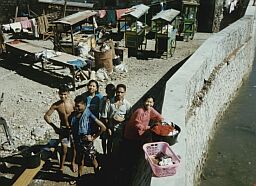 It certainly felt great to be back in Asia! The
streets of Kupang were bustling with people and lined with food stalls and small shops
selling just about everything. The brightly lit and colorful bemos belted out music
while competing for passengers. The air was full of the heavy sent of the food, the clove
cigarettes and the odour of the open sewers. The people seemed warm, friendly, easy going
and not to pushy towards us. As in most third world countries the town's river was many
things to the locals - play pool for the children, communal laundry, bathroom and garbage
tip!
It certainly felt great to be back in Asia! The
streets of Kupang were bustling with people and lined with food stalls and small shops
selling just about everything. The brightly lit and colorful bemos belted out music
while competing for passengers. The air was full of the heavy sent of the food, the clove
cigarettes and the odour of the open sewers. The people seemed warm, friendly, easy going
and not to pushy towards us. As in most third world countries the town's river was many
things to the locals - play pool for the children, communal laundry, bathroom and garbage
tip!
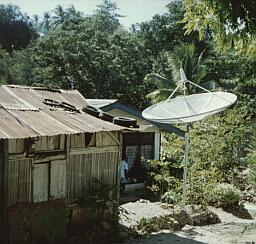 I had spent some time in Australia learning a little
of the Indonesian language and this seemed to be well appreciated by the locals. I spent
several days exploring Kupang town and adjusting to being back in the third world. I was
also awaiting the arrival of Michelle and Lindsay, two South African girls whom I had met
in Australia and had arranged to travel with through Indonesia. One day I did a day trip
up to Soe, a small hill town in the interior at an altitude of 800m. It was a pleasant bus
ride out to the town and I got to see a little of the surrounding countryside. The town's
market was quite interesting, but the feature that really caught my eye was that many of
the basic houses (shacks) were equipped with satellite dishes! It was amazing to see that
they had satellite TV but no running water or sewer system.
I had spent some time in Australia learning a little
of the Indonesian language and this seemed to be well appreciated by the locals. I spent
several days exploring Kupang town and adjusting to being back in the third world. I was
also awaiting the arrival of Michelle and Lindsay, two South African girls whom I had met
in Australia and had arranged to travel with through Indonesia. One day I did a day trip
up to Soe, a small hill town in the interior at an altitude of 800m. It was a pleasant bus
ride out to the town and I got to see a little of the surrounding countryside. The town's
market was quite interesting, but the feature that really caught my eye was that many of
the basic houses (shacks) were equipped with satellite dishes! It was amazing to see that
they had satellite TV but no running water or sewer system.
Michelle and Lindsay arrived as planned and we took a few days to decide on a rough itinerary for our trip through Indonesia. We finally agreed that our next stop would be the island of Sumba. Being off the main arc of islands that make up Nusa Tenggara, Sumba had avoided the successive streams of Hindu. Muslim and Christian invaders. The island's relative isolation had allowed it to retain a more traditional way of life with animist beliefs. Sumba was also famous for it's horses, strong slaves and sandalwood.
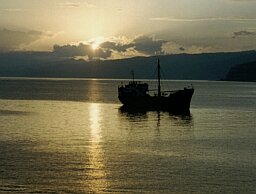 We set off from the port near Kupang for the trip to
Waingapu in Sumba. The first leg of the trip was a 14 hour sailing to Ende on Flores. The
ferry was just as I had expected it would be. The lower deck had a few vehicles, piles of
rice sacks, goats, pigs, chickens and seemingly thousands of Indonesians trying to mark
out a little territory with their mats. We quickly realized that our 'Economy' class
tickets were for this deck, but I decided to go up to 'First' class anyway. 'First' class
was little better except for the fact that there were plastic seats to sit on! After a bit
of quick thinking I decided that our best bet might be to sleep up on the roof of the
'First' class deck. We climbed up a ladder at the rear of the ferry and were relieved to
find that the roof was totally empty, except for a few crew members. The crew seemed happy
to let us stay there, but warned us that the roof was weak so we shouldn't all sleep too
close together! The sun soon began to set and it wasn't long before we settled down to
sleep under the stars. Our night out on the Savu sea was pretty peaceful apart from the
odd rat scurrying passed us.
We set off from the port near Kupang for the trip to
Waingapu in Sumba. The first leg of the trip was a 14 hour sailing to Ende on Flores. The
ferry was just as I had expected it would be. The lower deck had a few vehicles, piles of
rice sacks, goats, pigs, chickens and seemingly thousands of Indonesians trying to mark
out a little territory with their mats. We quickly realized that our 'Economy' class
tickets were for this deck, but I decided to go up to 'First' class anyway. 'First' class
was little better except for the fact that there were plastic seats to sit on! After a bit
of quick thinking I decided that our best bet might be to sleep up on the roof of the
'First' class deck. We climbed up a ladder at the rear of the ferry and were relieved to
find that the roof was totally empty, except for a few crew members. The crew seemed happy
to let us stay there, but warned us that the roof was weak so we shouldn't all sleep too
close together! The sun soon began to set and it wasn't long before we settled down to
sleep under the stars. Our night out on the Savu sea was pretty peaceful apart from the
odd rat scurrying passed us.
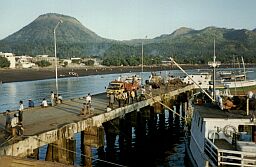 As the sun rose we pulled into the beautiful harbour
of Ende on Flores. The setting was magical with the town of Ende on the waters edge and
hemmed in by dramatic volcanoes. The town was covered in a light swirling morning mist and
the harbour was teaming with fishing boats and small canoes. As the sun got higher the
lush green backdrop of the town became more visible and the sounds of the awakening town
filled the air. We had been on the boat for 15 hours so our priority was to find somewhere
to freshen up and grab a bite to eat. We had a little explore around the town and then at
17.00 hrs we were back on the ferry and setting off for the 10 hour sailing to Sumba.
As the sun rose we pulled into the beautiful harbour
of Ende on Flores. The setting was magical with the town of Ende on the waters edge and
hemmed in by dramatic volcanoes. The town was covered in a light swirling morning mist and
the harbour was teaming with fishing boats and small canoes. As the sun got higher the
lush green backdrop of the town became more visible and the sounds of the awakening town
filled the air. We had been on the boat for 15 hours so our priority was to find somewhere
to freshen up and grab a bite to eat. We had a little explore around the town and then at
17.00 hrs we were back on the ferry and setting off for the 10 hour sailing to Sumba.
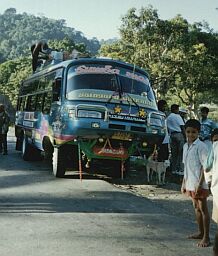 After another night at sea under the stars we arrived
at the port of Waingapu on the island of Sumba. We decided to immediately catch a
bus across the island to the western Sumba capital of Waikabubak. The bus looked
like some kind of lunar vehicle and was equipped with fairy lights and an amplifier more
powerful than the engine! The 140km journey across the island took us up into the hills,
across some open countryside, passed some beautifully terraced rice paddies and then
finally into Waikabubak. Waikabubak's altitude of almost 800m gave it a delightful climate
and made it very comfortable to explore. The town's people seemed exceptionally friendly
and we enjoyed several days relaxing and recovering from our two nights at sea. Our
primary reason for coming to Waikabubak was to explore the nearby Anakalang region which
had the greatest concentration of the famous Sumban megalithic tombs.
After another night at sea under the stars we arrived
at the port of Waingapu on the island of Sumba. We decided to immediately catch a
bus across the island to the western Sumba capital of Waikabubak. The bus looked
like some kind of lunar vehicle and was equipped with fairy lights and an amplifier more
powerful than the engine! The 140km journey across the island took us up into the hills,
across some open countryside, passed some beautifully terraced rice paddies and then
finally into Waikabubak. Waikabubak's altitude of almost 800m gave it a delightful climate
and made it very comfortable to explore. The town's people seemed exceptionally friendly
and we enjoyed several days relaxing and recovering from our two nights at sea. Our
primary reason for coming to Waikabubak was to explore the nearby Anakalang region which
had the greatest concentration of the famous Sumban megalithic tombs.
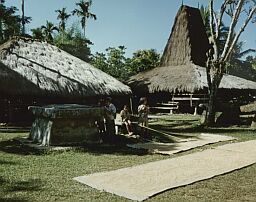
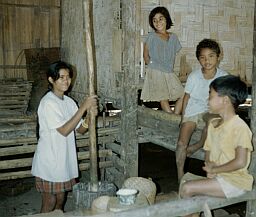 In the Anakalang region we visited several villages
including Pasunga. These villages were arranged around their ancestral tombs in a manner
to resemble a ship. The villages seemed completely untouched and the inhabitants living a
way of life that has been unchanged for many centuries. In Kabunduk we visited the largest
megalithic tomb in Sumba - weighing 70 tonnes and that had required 2,000 men to quarry it
and haul it to the burial site.
In the Anakalang region we visited several villages
including Pasunga. These villages were arranged around their ancestral tombs in a manner
to resemble a ship. The villages seemed completely untouched and the inhabitants living a
way of life that has been unchanged for many centuries. In Kabunduk we visited the largest
megalithic tomb in Sumba - weighing 70 tonnes and that had required 2,000 men to quarry it
and haul it to the burial site.
Next we decided to go an explore the more remote western coast. We managed to stay the night in one of the traditional villages called Wainyapu. The setting was beautiful with the river flowing down to the sea, the tropical beach and the high thatched roofs of the village poking through the lush vegetation. It was a real experience staying the night in such a primitive village, sleeping on the bamboo mats, washing in the river with the locals and being entertained by the village's children in the evening!
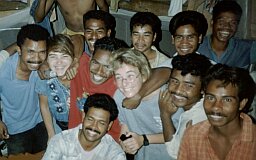 From the village of Wainyapu we had a 20km trek to
Gaura. After 3 hours walking along the sandy track and with the heat of the day draining
us, we decided we should try and hitch a ride. We waited for about an hour an then a truck
came along packed with people, we climbed aboard and were on our way. The truck took us to
a chocolate plantation near Gaura and dropped us off at the workers quarters. All the
workers were incredibly friendly and insisted on sharing their lunches with us. They
explained that we could stay in their dorm for the night for free. I couldn't imagine what
it was going to be like sleeping in an all male dorm trying to protect Michelle and
Lindsay, whom they were all in love with! Luckily we managed to get a lift on a farm truck
back to Waikabubak.
From the village of Wainyapu we had a 20km trek to
Gaura. After 3 hours walking along the sandy track and with the heat of the day draining
us, we decided we should try and hitch a ride. We waited for about an hour an then a truck
came along packed with people, we climbed aboard and were on our way. The truck took us to
a chocolate plantation near Gaura and dropped us off at the workers quarters. All the
workers were incredibly friendly and insisted on sharing their lunches with us. They
explained that we could stay in their dorm for the night for free. I couldn't imagine what
it was going to be like sleeping in an all male dorm trying to protect Michelle and
Lindsay, whom they were all in love with! Luckily we managed to get a lift on a farm truck
back to Waikabubak.
On 23rd June we caught and evening ferry ride back across to Ende in Flores. From Ende we caught a bus up to the village of Moni, from where we would organize our trip up to the colored crater lakes of Kelimutu. The bus was actually full so Michelle and I had to literally hang off the roof ladder at the back of the vehicle. It was quite a thrill clinging to the back of the bus while we climbed the torturous roads up to Moni.
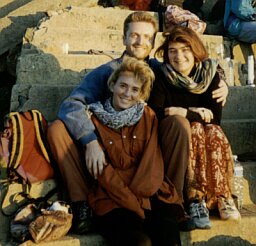
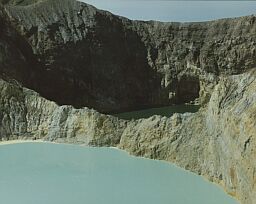 We spent the night at Moni and then at 4.00am the
following morning climbed aboard the truck that would take us up towards Kelimutu. The
truck took us to the head of the road and then it was a further hour trek up to the
craters. It was a magical sight staring down over the three colored lakes as the sun rose
behind the volcanoes. There were three crater lakes; the blue lake where the souls of the
young dead resided; the green lake where the older dead went; an the red/black lake that
was for the souls of the evil!
We spent the night at Moni and then at 4.00am the
following morning climbed aboard the truck that would take us up towards Kelimutu. The
truck took us to the head of the road and then it was a further hour trek up to the
craters. It was a magical sight staring down over the three colored lakes as the sun rose
behind the volcanoes. There were three crater lakes; the blue lake where the souls of the
young dead resided; the green lake where the older dead went; an the red/black lake that
was for the souls of the evil!
After visiting the spectacular crater lakes of Kelimutu we returned to Ende and then traveled east to the town of Bajawa. The 150km journey took us 7 hours due to the extreme mountainous landscape of Flores. Unfortunately most of the locals were not good travelers and many of them were sick as we negotiated the countless curves and hairpin bends. From Bajawa it was a further 10 hours of torture to the port of Labuan Bajo on the eastern tip of Flores.
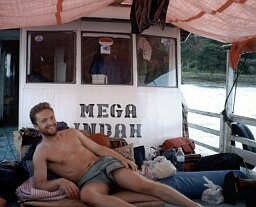
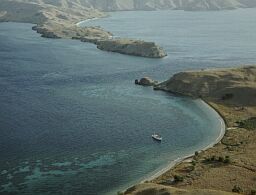 From Labuan Bajo we organized a five day boat trip
from Flores to Lombok, visiting the islands of Rincha, Komodo and Sumbawa. On 1st July we
boarded our boat the 'Mega Indah' and set sail at 9.30am. There were no cabins so we were
to live, eat and sleep on the deck! Luckily we seemed to have a good group so the prospect
wasn't too daunting. After a short time at sea we moored off the Island of Bidadari and
did some great snorkeling over the coral garden. The coral and fish life were as
impressive as I have seen anywhere!
From Labuan Bajo we organized a five day boat trip
from Flores to Lombok, visiting the islands of Rincha, Komodo and Sumbawa. On 1st July we
boarded our boat the 'Mega Indah' and set sail at 9.30am. There were no cabins so we were
to live, eat and sleep on the deck! Luckily we seemed to have a good group so the prospect
wasn't too daunting. After a short time at sea we moored off the Island of Bidadari and
did some great snorkeling over the coral garden. The coral and fish life were as
impressive as I have seen anywhere!
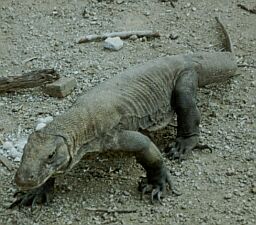 One of the highlights of the trip was of course the
visit to Komodo Island. On the island we soon spotted some of the prehistoric looking
Komodo Dragons. The huge creatures were 3m to 4m in length, weighed over 100kg and had
long blue forked tongues - some gecko! The island also had quite strange vegetation and I
really felt that we had stumbled into a real life 'Jurassic Park'. There were palm like
trees growing next to cacti and rolling hills covered in a course grass. On the walking
safari of the island we also spotted Water Buffalo, deer, horses and wild pigs. After
Komodo Island we steamed towards Flying Fox Island and arrived before sunset, just in time
to see the millions of bats emerge from their daytime resting place. The bats formed a
huge swarming black cloud - spooky!
One of the highlights of the trip was of course the
visit to Komodo Island. On the island we soon spotted some of the prehistoric looking
Komodo Dragons. The huge creatures were 3m to 4m in length, weighed over 100kg and had
long blue forked tongues - some gecko! The island also had quite strange vegetation and I
really felt that we had stumbled into a real life 'Jurassic Park'. There were palm like
trees growing next to cacti and rolling hills covered in a course grass. On the walking
safari of the island we also spotted Water Buffalo, deer, horses and wild pigs. After
Komodo Island we steamed towards Flying Fox Island and arrived before sunset, just in time
to see the millions of bats emerge from their daytime resting place. The bats formed a
huge swarming black cloud - spooky!
After Komodo we had several more days at sea, sailing along the coast of Sumbawa up to Lombok. We stopped off at several other great snorkel sites, visited a couple of villages and did a hike up to the summit of a 600m mountain for a spectacular view of the islands. We arrived at the island of Lombok on the evening of 5th July and quickly headed out to the Gili Islands. We went to Gili Trawangan which was an established traveler hangout with great beaches, snorkeling and a party atmosphere. Unfortunately after a day I came down with a high fever and had to rush back to the hospital in Lombok. The doctors, despite a negative blood test, diagnosed Malaria and pumped be full of the corresponding drugs. After a miserable 5 days I seemed to be on the mend, so Michelle and I decided to visit the traditional village of Tetebatu on the southern slopes of Mt. Rinjani. On the way to the village we realized that Michelle had been robbed and had lost her passport and all her money. We decided we would leave Lombok as soon as possible - we were convinced that Lombok must stand for 'island of disasters' in Indonesian.

 After a four hour ferry ride from Lombok we arrived
at the port of Padangbai in eastern Bali. We then spent a few days in the Aussie tourist
getto of Kuta doing what you do in Kuta - drinking too much! After Kuta we traveled up to
the town of Ubud in central Bali and began our exploration of this magical island. Ubud
had become much more developed since my previous visit in 1986, but was still a charming
place to hang out for week. While in Ubud we hired a jeep for three days with a couple of
other travelers and really explored the island.
After a four hour ferry ride from Lombok we arrived
at the port of Padangbai in eastern Bali. We then spent a few days in the Aussie tourist
getto of Kuta doing what you do in Kuta - drinking too much! After Kuta we traveled up to
the town of Ubud in central Bali and began our exploration of this magical island. Ubud
had become much more developed since my previous visit in 1986, but was still a charming
place to hang out for week. While in Ubud we hired a jeep for three days with a couple of
other travelers and really explored the island.
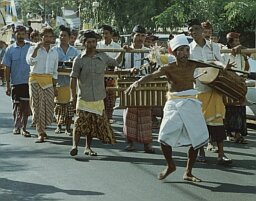
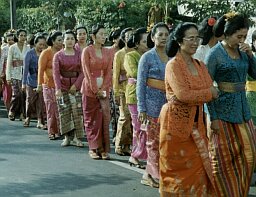 Bali is a predominantly Hindu island and is rich with
temples, shrines and festivals. The landscape is equally magical with the terraced rice
paddies, tropical beaches, lakes and magnificent volcanoes. Bali is the quintessential
Asia and a must for anyone exploring the region - development has certainly taken it's
toll, but Bali is still one of the most magical islands to visit on the planet. While
visiting the north of the island we stumbled upon the pre-cremation procession in the town
of Singaraja. As with all festivals in Bali it was a blaze of color, music, dance and
ceremony. We were all so impressed that we decided to return the following day to see the
actual cremation ceremony.
Bali is a predominantly Hindu island and is rich with
temples, shrines and festivals. The landscape is equally magical with the terraced rice
paddies, tropical beaches, lakes and magnificent volcanoes. Bali is the quintessential
Asia and a must for anyone exploring the region - development has certainly taken it's
toll, but Bali is still one of the most magical islands to visit on the planet. While
visiting the north of the island we stumbled upon the pre-cremation procession in the town
of Singaraja. As with all festivals in Bali it was a blaze of color, music, dance and
ceremony. We were all so impressed that we decided to return the following day to see the
actual cremation ceremony.

 The cremation was of a local priest and so was a
fairly extravagant affair. The emphasis seemed to be on the celebration of his life and
his passing to the next life, rather than the mourning associated with most Christian
burials. We followed the cremation procession to a temple and watched as they placed the
dead priest into the body of a model bull. The bull was then set on fire to the sound of
the typical Indonesian gamelan orchestra. The image of the temple, the crowds of mourners,
the gamelan music and the burning bulls will remain imprinted on my memory for ever - a
magical scene to witness.
The cremation was of a local priest and so was a
fairly extravagant affair. The emphasis seemed to be on the celebration of his life and
his passing to the next life, rather than the mourning associated with most Christian
burials. We followed the cremation procession to a temple and watched as they placed the
dead priest into the body of a model bull. The bull was then set on fire to the sound of
the typical Indonesian gamelan orchestra. The image of the temple, the crowds of mourners,
the gamelan music and the burning bulls will remain imprinted on my memory for ever - a
magical scene to witness.
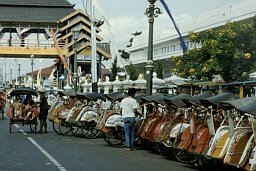 Next we were off to Java. At this point Michelle and
I decided to temporarily part paths, as she wanted to explore the Mt. Bromo volcano that I
had already climbed on my previous visit. I decided to travel directly onto to Yogyakata
and explore Java's cultural capital. One of the highlights of Yogya was an evening
watching the famous Wayang Kulit (Shadow puppets). The highly stylized figures together
with the Gamelan music were a surreal experience. The enthusiastic Becak (Cycle rickshaw)
drivers weaving through the city's traffic were also a memorable sight!
Next we were off to Java. At this point Michelle and
I decided to temporarily part paths, as she wanted to explore the Mt. Bromo volcano that I
had already climbed on my previous visit. I decided to travel directly onto to Yogyakata
and explore Java's cultural capital. One of the highlights of Yogya was an evening
watching the famous Wayang Kulit (Shadow puppets). The highly stylized figures together
with the Gamelan music were a surreal experience. The enthusiastic Becak (Cycle rickshaw)
drivers weaving through the city's traffic were also a memorable sight!
 Yogya was also the center for exploring the Hindu
temple of Prambanan and the Buddhist temple of Borobudur. Prambanan is the largest Hindu
complex in Java and was built around 900AD. The whole temple was decorated with fine
reliefs depicting the Javanese interpretation of the Hindu epic, Ramayana. The evening
after our visit we returned to watch an enactment of the Ramayana story. Watching the play
in the setting of such an impressive temple was another unforgettable experience.
Yogya was also the center for exploring the Hindu
temple of Prambanan and the Buddhist temple of Borobudur. Prambanan is the largest Hindu
complex in Java and was built around 900AD. The whole temple was decorated with fine
reliefs depicting the Javanese interpretation of the Hindu epic, Ramayana. The evening
after our visit we returned to watch an enactment of the Ramayana story. Watching the play
in the setting of such an impressive temple was another unforgettable experience.
 Our visit to the Buddhist temple of Borobudur was
another highlight of my visit to Java. Borobudur, one of the greatest Buddhist monuments
in the world, was also built around 900AD. The structure was a 9 tiered 'mountain' rising
35m, decorated with 5km of fine reliefs, 500 statues of Buddha and constructed of 1.6
million blocks! The different levels of the temple represent the transition from reality
through 10 psychological states towards the ultimate level of enlightenment, Nirvana.
Our visit to the Buddhist temple of Borobudur was
another highlight of my visit to Java. Borobudur, one of the greatest Buddhist monuments
in the world, was also built around 900AD. The structure was a 9 tiered 'mountain' rising
35m, decorated with 5km of fine reliefs, 500 statues of Buddha and constructed of 1.6
million blocks! The different levels of the temple represent the transition from reality
through 10 psychological states towards the ultimate level of enlightenment, Nirvana.
 From Yogya I caught the train up to the city of
Bandung at an altitude of 750m. The train fare was a bargain at $1.50 for the 10 hour
journey! After a brief look around Indonesia's high tech capital I caught another train on
to Bogor, where I spent a night and visited the famous botanical gardens - not really my
scene. From bogor I continued by train down to Jakarta. I had last been in Jakarta 10
years previous, when Mark and I had been robbed of all our valuables. This time I was
determined to explore Old Batavia, and the old Dutch port of Sunda Kelapa with the
magnificent Buginese Makassar schooners. Jakarta is one of the few places in the world
where one can see these old schooners still earning a living.
From Yogya I caught the train up to the city of
Bandung at an altitude of 750m. The train fare was a bargain at $1.50 for the 10 hour
journey! After a brief look around Indonesia's high tech capital I caught another train on
to Bogor, where I spent a night and visited the famous botanical gardens - not really my
scene. From bogor I continued by train down to Jakarta. I had last been in Jakarta 10
years previous, when Mark and I had been robbed of all our valuables. This time I was
determined to explore Old Batavia, and the old Dutch port of Sunda Kelapa with the
magnificent Buginese Makassar schooners. Jakarta is one of the few places in the world
where one can see these old schooners still earning a living.
Michelle and I met up in Jakarta as planned. We had been in Indonesia for a full two months and so needed to hop over to Singapore in order to renew our visas. On 5th August we took the short flight from Jakarta to Singapore.